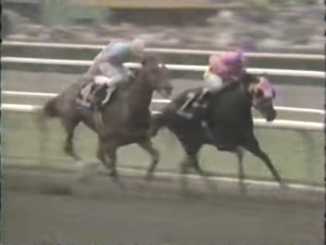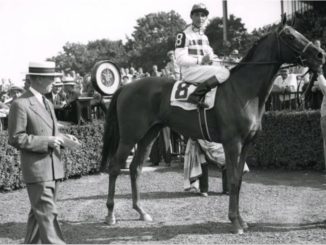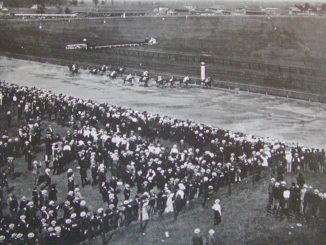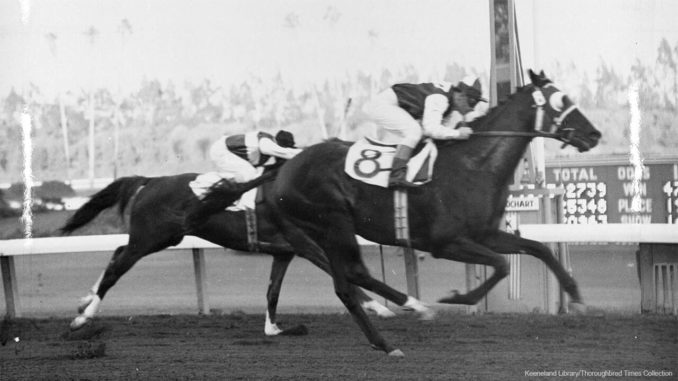
Seventy years ago this week, 50,000 fans congregated at Hollywood Park to witness what must be considered among the finest assemblages of Thoroughbred accomplishment for any race of that era, and to this day certainly one of the best of all time.
That a race of such caliber would be held in December is unusual by today’s standards and was even more so in that era, when few if any stakes of national significance were held beyond October.
The extenuating circumstances surrounding the race’s date, however, meant there was little on the line other than the most lucrative payday of the season and, to a lesser extent, pride.
A disastrous fire that consumed the entire facility shortly before the start of Hollywood Park’s 1949 season resulted in a frantic rush to rebuild in time for 1950. When reconstruction was slowed down, a decision was made to split the normal Hollywood Park season of 50 days into two meets. Twenty racing days were held from June 27 through July 22, while a 30-day session, that would prove a critical if not relative financial success, was scheduled from Nov. 7 through Dec. 16, a typically barren time of the year for top-class racing.
The centerpiece of the fall meet would be the Hollywood Gold Cup, a handicap over 1 1/4 miles for 3-year-olds and up, on Dec. 9. The Gold Cup’s gross purse was $135,000, the equivalent of more than $1.4 million today. The winner’s share was a season-high $100,000, richer than that year’s Santa Anita Handicap, Kentucky Derby, Santa Anita Derby, and Futurity.
The decision to split the 1950 Hollywood Park meet in two was correctly considered a one-off, thus there was apparently little resolve to adjust the date of balloting for the season’s champions by either of the main voting entities. Daily Racing Form announced its champions on Nov. 13, while a new poll inaugurated by the Thoroughbred Racing Association was released days before the Gold Cup was run.
Instead of being a championship-deciding race like the Breeders’ Cup Classic (G1), the 1950 Hollywood Gold Cup was instead more like a Pegasus World Cup (G1), filled with recently honored champions and an opportunity for one of them to make his racing swan song.
Hollywood Gold Cup Protagonists
The Gold Cup’s two protagonists were Hill Prince and Noor. Although beaten in the Kentucky Derby and Belmont Stakes by Middleground, Hill Prince had asserted his superiority over that rival in four other meetings, including the Preakness. In addition to the 3-year-old male title Hill Prince was voted Horse of the Year, largely due to a four-length victory over the 5-year-old Noor in the two-mile Jockey Club Gold Cup at Belmont Park on Oct. 7, a race in which both carried scale weights (Hill Prince 117, Noor 124).
Despite his loss at odds-on in the Jockey Club Gold Cup, and a narrower one in the Manhattan Handicap in his other New York stakes appearance, there was no questioning Noor’s claim on the older male title. An Irish-bred who had run third in the 1948 Epsom Derby prior to his importation, the son of Nasrullah had proven himself king of California earlier in the season by beating the mighty Citation four consecutive times.
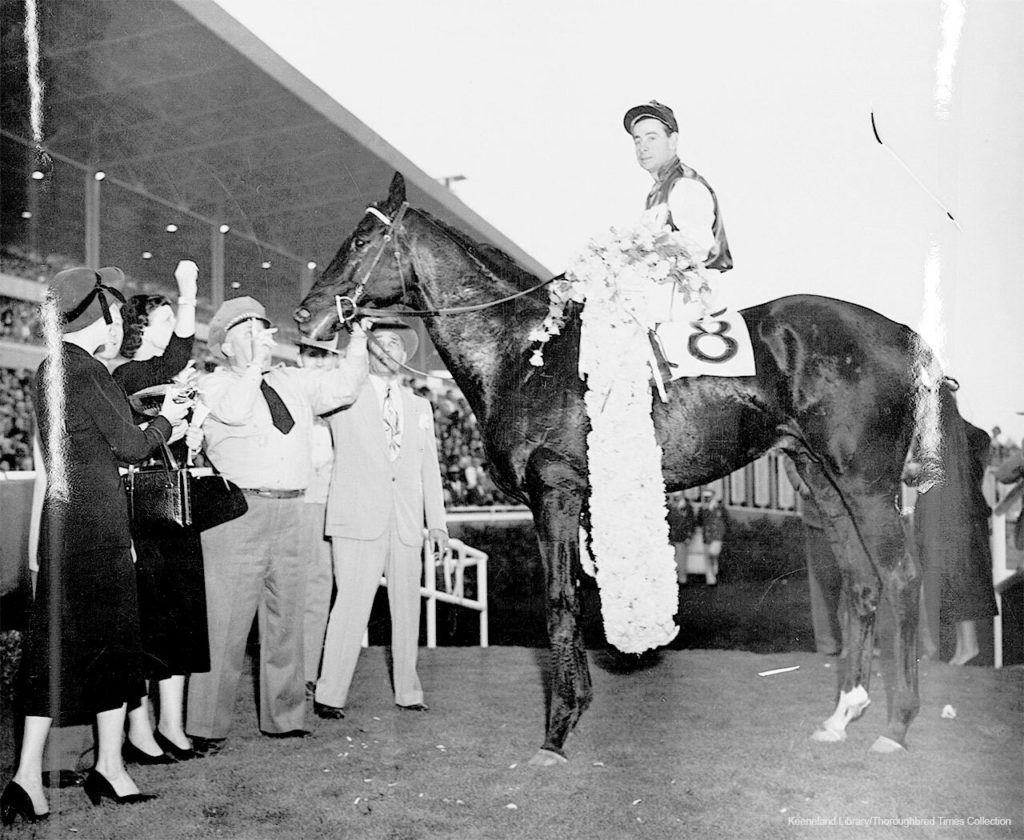
After receiving considerable weight concessions from the former Triple Crown winner in the Santa Anita Handicap, in an epic renewal of the San Juan Capistrano Handicap, and in the Forty-Niners Handicap at Golden Gate Fields, Noor beat Citation a fourth time, in the Golden Gate Handicap, by three lengths while giving the legend one pound. In all four victories Noor set new track records.
In his final start before going east, Noor captured the American Handicap at Hollywood over 1 1/4 miles while carrying 132 pounds. It was this collective record over the relatively hard California tracks that convinced observers and bettors Noor could turn the tables on Hill Prince in the Hollywood Gold Cup.
The timing of the Gold Cup could not have worked out better for either horse.
For Hill Prince, who was scheduled to winter in California to point for the lucrative Santa Anita meet anyway, it meant an early opportunity to adjust to new surroundings and the quicker surface conditions he would encounter. For Noor, it was a chance to meet Hill Prince once more on his home “turf” before heading into retirement following the death of owner Charles S. Howard that summer.
Prepping for the Gold Cup
Hill Prince and Noor each had the benefit of a local prep heading into the Gold Cup. Hill Prince made his Southern California debut in the 1 1/16-mile Thanksgiving Day Handicap, in which he finished third by a head to the local speedster Your Host, the beaten favorite in the Kentucky Derby and future sire of five-time Horse of the Year Kelso. Your Host would not run back in the Gold Cup as the distance was judged too far for his liking.
Noor, on the other hand, was a convincing seventh-length winner of a 1 1/8-mile allowance prep held eight days before the Gold Cup. In it he had defeated two other Gold Cup participants in yet another track-record performance.
With such star power at the top, it’s a wonder the Gold Cup was able to attract six other entrants.
The purse of the race was an undoubted enticement, though, as was the fact that both Hill Prince and Noor would carry significantly more weight under the race’s handicap conditions. By contrast, only three others had shown up to face the two heavyweights in the weight-for-age Jockey Club Gold Cup.
The third newly-crowned champion in the Gold Cup field was the only female in the race, Next Move. Bred in California by owner Alfred G. Vanderbilt, Next Move had won five stakes in advance of being named champion 3-year-old filly, including the Coaching Club American Oaks, Beldame Handicap, and Ladies Handicap, the latter two against older mares. Next Move won two more stakes early in the Hollywood fall meet, including the Vanity Handicap.
A former champion in the mix was Assault, the 1946 Triple Crown winner and Horse of the Year. Returned to the track after proving sterile at stud, Assault won his comeback from a 13-month layoff at Hollywood on Nov. 22 going 7 furlongs, but had been beaten eight lengths by Noor in the aforementioned 1 1/8-mile allowance, a race in which it was determined Assault had bled slightly.
Another former Kentucky Derby winner in the Gold Cup lineup was Ponder, who had captured the Run for the Roses in 1949 for Calumet Farm. Although considered Calumet’s second best older horse that year behind Citation, Ponder had beaten Noor and Citation in the San Antonio Handicap in February and had earned other big wins over the summer at Tanforan and Arlington Park.
The remaining three Gold Cup hopefuls were longer shots.
The multiple stakes-winning Palestinian placed in all three Triple Crown events in 1949 and had finished in between Noor and Assault in the Dec. 1 allowance prep. Great Circle, a 3-year-old, had previously captured the Cinema Handicap and Del Mar Derby, while the veteran California-bred On Trust was nearing the end of a long career that would be remembered into the 21st century when Hollywood Park ran a restricted stakes in his honor.
A Golden Day
Gold Cup Day was bright and sunny, the track was fast, and many parts of the nation were able to listen to the action on their CBS Radio affiliate shortly after 4 p.m. Pacific.
The only real cause for complaint from any quarter would have come from the Hill Prince camp. Both the reigning Horse of the Year and Noor were assigned 130 pounds for the Gold Cup, a significant weight shift from their prior meeting two months earlier. As a 3-year-old Hill Prince was the theoretical highweight, giving Noor six pounds on the scale.
The largely partisan crowd at Hollywood made Noor an odds-on, 7-10 favorite. Hill Prince was 7-2, and Ponder was the only other horse in single digits at 5-1.
Hill Prince and Noor broke side by side in posts 7 and 8, respectively.
After bumping each other slightly at the start, the two favorites settle near the back of the field while the filly Next Move produced a strong pace — :46.60 to the half-mile, 1:10.20 to the 6-furlong mark, and 1:35 to the mile.
In what turned out to be somewhat of a rider’s race, Johnny Longden kept Noor outside and in the clear around the far turn while Eddie Arcaro continued to save as much ground as he could with Hill Prince given the weight burden. That decision by Arcaro would prove fateful.
“I felt I had to save some ground in the Gold Cup with Hill Prince because at the weights I wasn’t sure I had the better horse,”
Arcaro said.
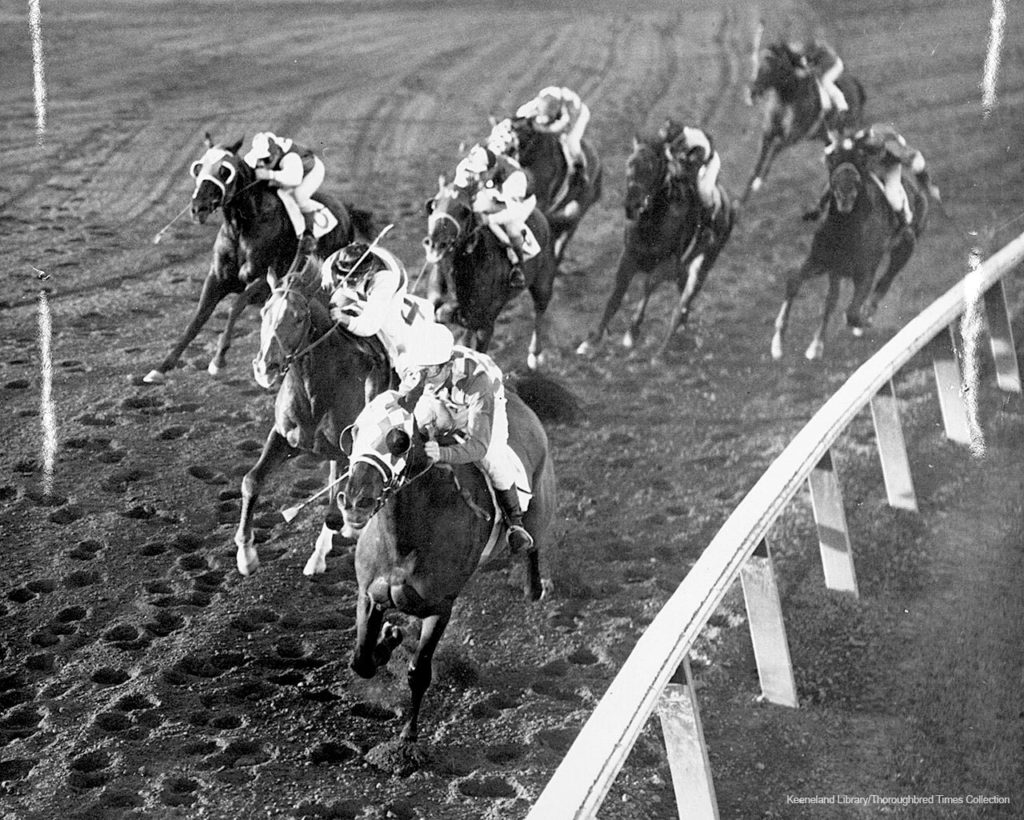
On Trust, and Ponder turning for home in the 1950 Hollywood Gold Cup
(Keeneland Library/Thoroughbred Times Collection)
Approaching the turn for home Palestinian, who had been chasing Next Move from second throughout, was poised to take the lead from the filly, with Noor also gaining ground on the outside. Arcaro was hoping to slip Hill Prince inside tiring rivals in front of him to also challenge for the lead, but quickly discovered whatever opening had existed no longer did. By the time Hill Prince recovered from checking and changed to an outside lane, his chances of winning were over.
Up ahead, the 36-1 Palestinian made a short lead at the eighth pole, but gobbling up ground on the outside was Noor, who worked his way to the front inside the final sixteenth and was drawing away at the finish to win by a length. The final time was 1:59.80, the sixth track record set by Noor that season.
Hill Prince was beaten three lengths for second by Palestinian, while Next Move weakened to fourth in what was nonetheless a good effort for a 3-year-old filly. Ponder, Great Circle, Assault, and On Trust completed the order of finish.
After the Gold Cup
One week after the Gold Cup, with Noor and Assault retired and Ponder all but, Hill Prince carried 128 pounds to victory in the 9-furlong Sunset Handicap at Hollywood by three parts of a length, conceding 14 pounds to Next Move and 19 pounds to Great Circle, respectively.
Hill Prince did not compete at Santa Anita that winter owing to a fractured hind leg. He made it back to the track in the autumn of 1951, when he won or placed in three of four stakes appearances, just enough to succeed Noor as champion older male. He was retired in early 1952 after two runs at Santa Anita.
Hill Prince was inducted into the Hall of Fame in 1991, 27 years after Assault. Noor belatedly joined those two in 2002.
Click here to listen to the 1950 Gold Cup race call by Hollywood Park announcer Hal Moore:

